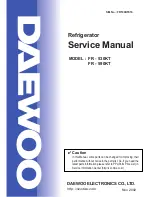
22
Product Specifications
■
Condenser
1) Role: A device which radiates heat to the outside of the refrigerator. As this heat is
dispersed, the high temperature/ high pressure vapor refrigerant changes to a
liquid state.
2) Types
A. Air-cooling Type : Condense air by circulating naturally or manually.
1) Natural Convection Type : Used for the household refrigerator which has small
condensing capacity. (No Fan)
2) Manual Convection Type : Circulate air manually by FAN-Motor (Large capacity)
B. Water-cooling Type : Make cooling water pass through the pipe in the condenser
(Large capacity)
※
Location
①
CLUSTER heat-radiating type : All Pipes effective for radiating heat are formed in
the right/left, and front side of refrigerator with hard urethanes and radiate heat
through the whole surfaces of cabinet to ambient air.
②
Install the condenser on the outside of the product. (An old model)
③
Make them cluster at the lower part of product and radiate heat manually by fan.
※
Radiate condensed potential heat up to liquefy completely and make change the
state without changing the gas temperature itself.
※
Pipe thickness
①
Low pressure: 6.3mm
②
High pressure : 4.7mm
③
Capillary : About 0.4-0.8mm
※
Condenser length (Based on 300ℓ): 26.5 M
①
Assistance : 5 M
②
HOT-PIPE: 6.6 M
③
CLUSTER-PIPE: 4.17 M
■
Capillary
1. Role: A device which makes low temperature and pressure refrigerant by reducing
the pressure the normal temperature / high pressure liquid refrigerant condensed
from condenser, and supply it to the evaporator.
A. To evaporate more lower temperature in case of evaporation.
B. It flows to the evaporator without back flowing to condenser, if compressor stops,
and the difference of pressure between high pressure and low pressure is small so
it is easy to operate the compressor again.
2. Outline
A. Thickness : About 0.4-0.8ßÆ
B. Length : It is changeable to low temperature and pressure (10->5ß∏/ß≤) depends
on the 2M of thin and long copper pipe wall resistance.
2-7-2. Operation theory of refrigeration cycle components
















































